
A blog focusing on 1/64 diecast from such popular brands as Hot Wheels, Matchbox, Johnny Lightning, M2 Machines, GreenLight, Tomica, Yat Ming, Majorette, MotorMax, Siku, Corgi, Guisval, Playart, Ertl, Zylmex, Racing Champions, & many more. Swifty's Garage features a daily Car Of The Day and news updates from your favorite brands!
Monday, August 22, 2011
Car Of The Day: August 22, 2011
Today's car of the day is Racing Champions Speed Wheels' 1970 Chevrolet Chevelle SS.
The Chevrolet Chevelle is a mid-sized automobile produced by the Chevrolet division of General Motors in three generations for the 1964 through 1977 model years. Part of the GM A-Body platform, the Chevelle was one of Chevrolet's most successful nameplates. Body styles include coupes, sedans, convertibles and station wagons. Super Sport versions were produced through the 1973 model year, and Lagunas from 1973 through 1976. After a three year absence, the El Camino was reintroduced as part of the new Chevelle lineup. The Chevelle also provided the platform for the Monte Carlo introduced in 1970. The Malibu, the top of the line model through 1972, replaced the Chevelle nameplate for the redesigned, downsized 1978 models.
For more information and pictures of the real car please visit: Chevrolet Chevelle
This one is from the same ill-fated series that brought us *N Sync tampos on an Olds 442. To give you an idea of how poorly this sold, I bought this car new at Kiddie Kar about a month ago. It came out about a decade ago. That should say everything right there...
The 1968 Chevelle got an all-new distinctly sculpted body with tapered front fenders and a rounded beltline. The car adopted a long-hood/short-deck profile with a high rear-quarter "kick-up". While all 1967 Chevelle models rode a 115-inch (2,900 mm) wheelbase, the 1968 coupes and convertibles now rode a sporty 112-inch (2,800 mm) wheelbase. The sedans and wagons turned to a 116-inch (2,900 mm) span. Tread width grew an inch front and rear. Hardtop coupes featured a semi-fastback, flowing roofline. Top-trim models (including the SS 396 and new luxury Concours) featured GM's new Hide-A-Way wiper system. Lesser Chevelles would get that change later. The Super Sport (SS 396 coupe and convertible) became series on its own. Chevrolet produced 60,499 SS 396 hardtops but only 2,286 convertibles. Black-accented Super Sports rode F70x14 red-stripe tires and carried a standard 325-horsepower 396-cubic-inch Turbo-Jet V-8 engine below the special twin-domed hood. 350 and 375-horsepower 396 engines could be substituted. The SS 396 Sport Coupe started at $2,899 - or $236 more than a comparable Malibu with its 307-cubic-inch V-8. All-vinyl bucket seats and a console were optional. The new Concours Sport Sedan focused on luxury, with special sound insulation, and a deep-padded instrument panel with simulated woodgrain accents and all-vinyl color-keyed interiors. Malibu gained a new Sport Sedan body style this year. The Concours Estate Wagon was one of four distinct Chevelle wagon models. A one year Nomad, Nomad Custom was offered. Regular Chevelle engines started with a 140 horsepower (100 kW) Turbo-Thrift six or the new 200 horsepower (150 kW) Turbo-Fire 307 V-8, but stretched to a 325 horsepower (242 kW) version of the 327-cubic-inch V-8. Manual transmission cars got GM's "Air Injection Reactor (A.I.R)" smog pump, which added complexity under the hood. New Federal safety-mandated equipment included side marker lights, as well as shoulder belts for outboard front seat occupants on cars built after December 1, 1967.
1969 Chevelles were billed as "America's most popular mid-size car." They showed only minor changes for 1969, led by revised front-end styling. A single chrome bar connected quad headlights, and a slotted bumper held the parking lights. Taillight lenses were larger and more vertical, flowing into the quarter panels. Front vent windows began to fade away now that Astro Ventilation was sending outside air into several Chevelle models. The Chevelle lineup slimmed down to two series: 300 Deluxe and Malibu. No longer a series of its own, the SS 396 turned into a $347.60 option package for any two-door model. That meant not just a convertible or hardtop Sport Coupe, but even the pillared coupe in the lower-rent 300 Deluxe series. A very few 300 Deluxe SS396-optioned pillared coupes were built, and they are solid gold for collectors. The Super Sport included a 325-horsepower 396-cubic-inch V-8 beneath a double-domed hood, along with a black-out grille displaying an SS emblem and a black rear panel. More potent editions of the 396 engine also made the options list, developing 350 or 375 horsepower (280 kW). A few hundred Chevelles even managed to acquire a 427-cubic-inch V-8, ordinarily installed only in full-size models. Chevelle station wagons came in three levels: Concours, Nomad, and Greenbrier—the last a badge formerly used on the Corvair van. A new dual-action tailgate operated either in the traditional manner or as a panel-type door. Wagons stretched 208 inches (5,300 mm) overall versus 197 inches (5,000 mm) for coupes. New round instrument pods replaced the former linear layout. Chevelle options included headlight washers, power windows and locks, and a rear defroster. Chevy's midsize production rose this year, with Malibus far more popular than their less-costly mates. Fewer than seven percent of Malibus had a six-cylinder engine, while more than 86,000 got an SS 396 option. All '69 Chevelles got a new locking steering column one year ahead of the Federal requirement, and headrests required for all cars sold in the U.S. after January 1, 1969.
In 1970, sheetmetal revisions gave the bodies a more squared-up stance, and interiors were redesigned, too. The 1970 Chevelles came in Sport Coupe, Sport Sedan, convertible, and four-door sedan—along with a pair of Super Sport upgrades. The SS option was now limited to the Malibu 2-door Sport Coupe and convertible. Later in the model year came a basic model, essentially a revival of the former 300 Deluxe; it was offered only as a Sport Coupe and sedan. New options included power door locks and a stalk-mounted wiper control. Engine choices ranged from the standard 155 horsepower (116 kW) six-cylinder and 200-horsepower 307-cubic-inch V-8, to a pair of 350 V-8s and a pair of 402 ( 396 ). Bigger engines became available as regular production options, resulting in the addition of an SS454 option.
The SS 396 Chevelle included a 350 horsepower (260 kW) Turbo-Jet 396 V-8, special suspension, "power dome" hood, black-accented grille, resilient rear-bumper insert, and wide-oval tires on sport wheels. Though a 375 horsepower (280 kW) upgrade was available, few were sold—primarily because the added cost brought the total too close to the SS 454. The 454-cubic-inch V-8, offering 360 horsepower (270 kW) in standard form but a whopping 450 horses in solid-lifter, high-compression, LS-6 guise. The latter made a Chevelle one of the quickest muscle cars ever built. "You can make our tough one even tougher," the brochure explained, by adding Cowl Induction to either SS model. Step on the gas, and a scoop opened "to shoot an extra breath of cool air into the engine air intake....like second wind to a distance runner." Functional hood lock pins completed the SS package. The 454 cu in (7.4 L) LS5 V8 was rated at 360 hp (270 kW). The LS6, with 450 hp (340 kW) and 500 ft·lbf (680 N·m) of torque, would provide 1⁄4 mi (400 m) strip performances in the low to mid-13 second range at 105–108 mph (169–174 km/h) and a 0-60 time of 6.1 seconds. The ZL1 and L88 427s both were rated at 430 hp (320 kW), but actually produced well over 500 hp (373 kW) in stock configurations. They were "race only" engines and very very few were ever installed in production cars. Most were ordered by racers who had factory connections or sold over the counter parts.
The 1971 Chevelles got fresh front-end styling that included large Power-Beam single-unit headlights, a reworked grille and bumper, and integral park/signal/marker lights. New dual round taillights were integral with the back bumper. Because SS models suffered heavy insurance surcharges, Chevrolet introduced the "Heavy Chevy" at midyear available with any V-8 engine except the 454, which was exclusive to SS models. For 1971, the base Chevelle SS engine was a two-barrel 350-cubic-inch V8 rated at 245 gross (165 net) horsepower. Optionally available was a four-barrel carbureted version of the 350 V8 rated at 275 gross (200 net) horsepower. The big block engines of previous years were now optional, including the 402 V8 rated at 300 gross (270 net) horsepower; and LS-5 454 V8 with 365 gross and 285 net horsepower. Chevrolet specifications for 1971 included both "gross" and "net" horsepower figures for all engines. The SS option could be ordered with any optional V8 and became more of a dress-up option than a performance option. GM mandated all divisions design their engines to run on lower-octane regular, low-lead or unleaded gasoline. To permit usage of the lower-octane fuels, all engines featured low compression ratios (9:1 and lower; well below the 10.25-11.25:1 range on high-performance engines of 1970 and earlier). This move reduced horsepower ratings on the big-block engines to 300 for the 402 cubic-inch V8 but surprisingly, the LS-5 454 option got an "advertised" five-horsepower increase to 365. The LS-6 454 option, which was originally announced as a regular production option on the Chevelle SS for 1971, was dropped early in the model year and no official records indicate that any 1971 Chevelles were assembled with the LS-6 engine.
1972 Chevelles wore single-unit parking/side marker lights on their front fenders, outside of a revised twin-bar grille. All Malibus had concealed wipers. Super Sport equipment could now be ordered with any V-8 engine, including the base 307-cubic-inch version. The 1972 Chevelle series had wide enough appeal to qualify as America's second-best-selling car. Base versions again included a four-model wagon series. Upscale versions were Malibus including the convertible models. More than 24,000 Malibu Sport Sedans were built, with a standard 307-cubic-inch V-8 rated at 130 (net) horsepower. With that V-8, the Malibu Sport Coupe was the top seller by far starting at $2,923. The six-cylinder version ran $90 less. Powertrain options included the 175-horsepower 350-cubic-inch V-8 and 240-horsepower 402-cubic-inch (still known as a 396), as well as a 454 that managed to put out 270 horsepower (200 kW) under the net rating system. Chevelles sold in California could not get the 307 V-8 but carried a 350-cubic-inch engine instead. Through the 1970s, California cars often had different powertrains than those marketed in states with less-stringent emissions regulations. 1972 is the last year popular for Chevelle car collectors.
Super Sport equipment could now be ordered with any V-8 engine, including the base 307-cubic-inch version. The 1972 Chevelle SS had a top engine rated at 270 net hp (201 kW) conforming with GM's decree that all engines were to be rated at their net engine ratings. Despite the lower rating there was no evidence that power had actually changed on production cars of that year. All other engines on the SS roster were unchanged from 1971. Chevelle wagons measured 10 inches (250 mm) shorter than full-size wagons and weighed about half a ton less, but sold much slower. Model-year output totaled 49,352 Chevelles and 290,008 Malibus—plus 54,335 station wagons.
And for the sheer irony factor of seeing "Matchbox" tampoed on the back of a Racing Champions casting, here's a closeup of the 2001 tour logo on the trunk.
Subscribe to:
Post Comments (Atom)
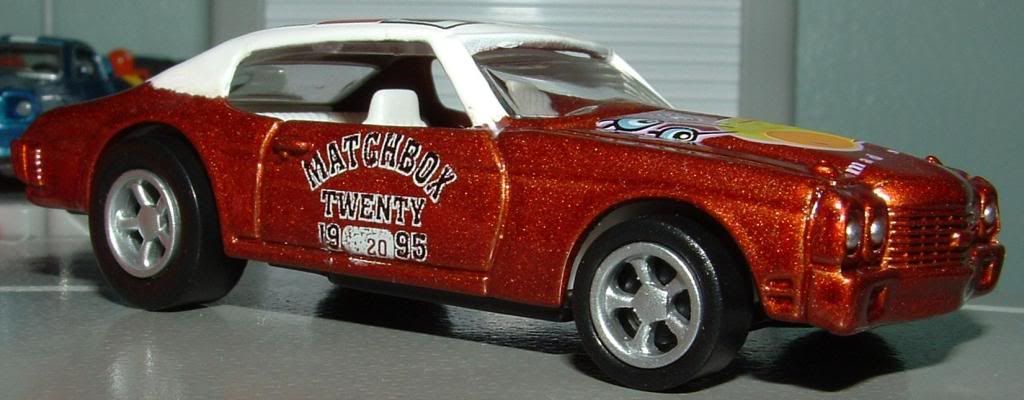
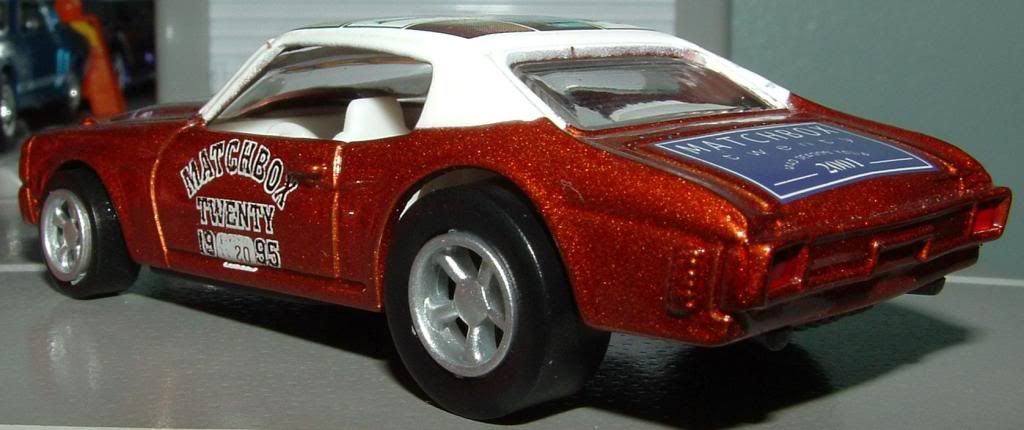
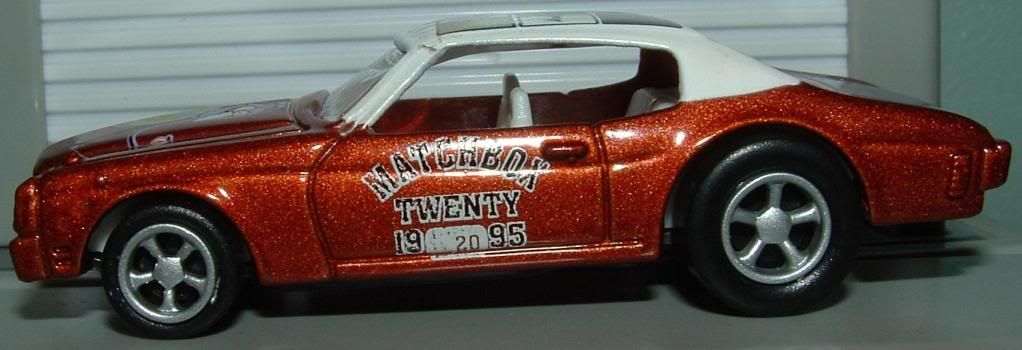
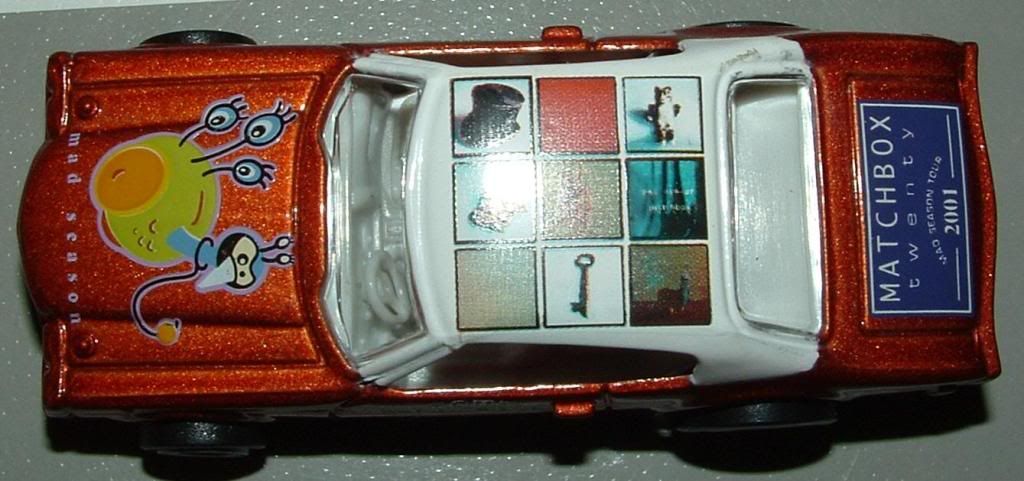
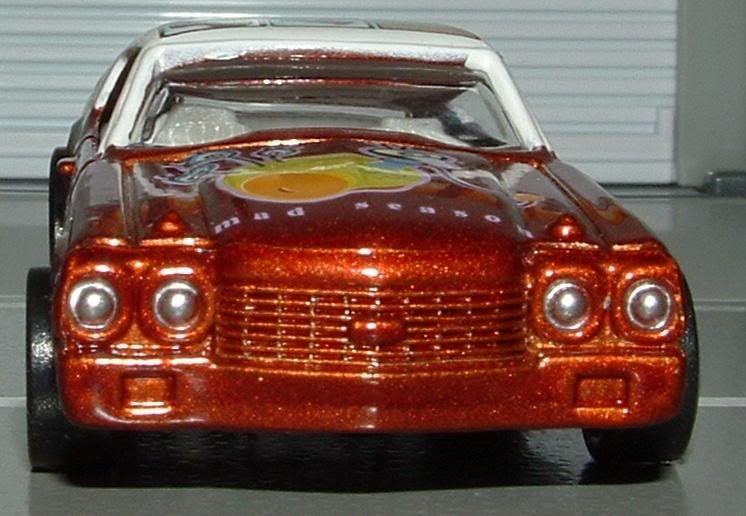
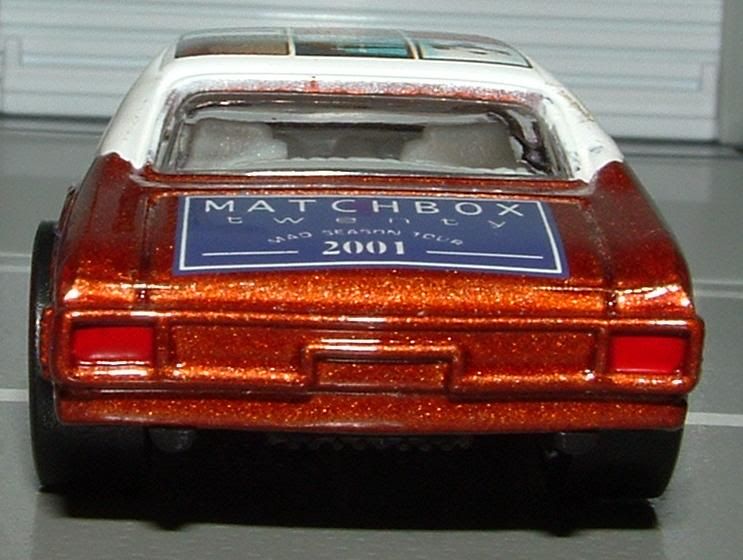

No comments:
Post a Comment